| Succulent plants, equipped naturally to survive long periods without rainfall, --like a fat person during a famine-- can serve gardeners well. These days, many people are excited by planting green roofs and living walls, and the smaller succulents are often absolutely the best species. (Every climate has a different list of best species.) Many freeze-sensitive succulents can be containerized easily, and brought inside during winter. As for edibility, few are toxic; and though numerous succulents taste acrid or are astringent, many are merely bland tasting, offering a pleasant crunch when leaves are added to salads; a few even taste gratifyingly acidic. Moreover, most succulents are among the easiest plants to propagate. This month I share with you what I have learned about Dudleya, a succulent genus of the SW United States and NW Mexico. |
| For decades, Reid Moran has studied and written about Dudleya. For most of the details in this article I give credit to him. He authored the generic treatment in the Flora of North America. As presently understood, genus Dudleya has 44 species, from SW Oregon to NW Mexico, east into Arizona. Mainly they are near San Diego. It was named in 1903 to commemorate William Russell Dudley (1849 - 1911), American botanist. Various of the species had before 1903 been going under other generic names, including Cotyledon, Echeveria, and Sedum. The different species vary in size from a few inches to several feet. Some are green leaved, most are at least glaucous if not powdery white --an adaptation to block the sun's UV light. Flowers are usually small, in clusters, often on colorful stems. Blooming time varies from (March) April into July. Leafy flowerstems arise from near the base of the plants usually (rarely from the plant center --as most Echeveria flowerstems do; and the latter are not leafy-stemmed.) According to Moran, "Though all Dudleya species readily hybridize, and also species of Echeveria, all attempts to cross Dudleya with Echeveria and relatives have failed." |
Dudleya cultivation is easy --if in the plants' native areas of dry summers and mostly mild winters. But taking a Dudleya to a wet-summer region, or to a winter freezing climate, or bringing one indoors, requires special care. The main needs are to plant in cactus and succulent potting soil so it gets superb drainage; to plant it high in a pot, at an angle, or on a slope if possible; to give it maximum sunshine and minimal summer water. Inside, it likely will not get enough light, so may get mealybugs or aphids, and will be drawn out, weak and gaunt. If you overwater it, rot is likely. If you have an indoor window that faces Southwest, that may be perfect in winter. But in the summer, the exposure may be too harsh, and part shade preferable. Each Dudleya species of course has slightly varying needs. I describe 8 below. I have only firsthand experience with 5. There are no barriers to crossing in Dudleya, so any number of hybrids can be made, and some may be better behaved in cultivation that their parents. Most propagation is via seed. If you search online, you will find that more Dudleya species are offered for sale as seeds than as living plants.
|
| Dudleya Brittonii Johans. 1933 |
| = D. grandis hort. |
| (Silver-Dollar Plant. Britton's or Giant Dudleya. Chalk Dudleya) |
| Baja California, on rocky cliffs and canyons. 2n = 34 |
The best-known Dudleya in cultivation. Named after Nathaniel Lord Britton (1859 - 1934). A solitary specimen rather than a spreading groundcover. Notable for its bold large size and nearly white color --a protective powder over its actually green leaves. Alas, it can only handle a bit of frost --if in perfect conditions. And it is more sensitive to imperfect drainage than most Dudleya. My Seattle garden specimen was killed last November by around 15 degrees F. Its basal leaf rosette can reach 16 inches or even 2 feet wide. The largest leaves measure up to 10 inches long by 3.5 inches wide. Flowerstems up to about 2 feet long are full of hundreds of old shriveled leaves. Its flowers are pale yellow or whitish, and the pink-red flowerstems are even more showy. It is prized as a foliage plant; the flowers are not necessary to ensure its popularity.
|
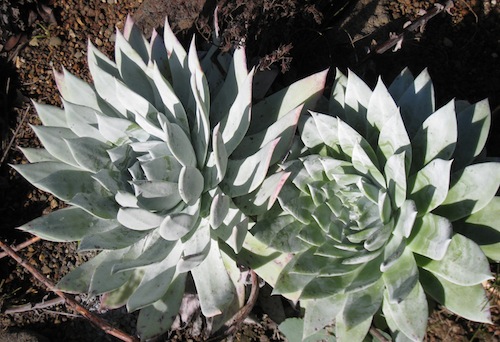
Dudleya Brittonii January 2011 in Berkeley (photo by ALJ)
|

Dudleya Brittonii May 2010 in San Diego (photo by ALJ)
|

Dudleya Brittonii remains; January 2011 in Seattle --after killer freeze (photo by ALJ)
|
| Dudleya cæspitosa (Haw.) Brit. & Rose 1903 |
| = Cotyledon cespitosa Haw. 1803 |
| (Sea Lettuce. Sand Lettuce. Coast Dudleya) |
| California, mostly near the coast. Polyploid: 2n = 102, 136 |
This is one of the most variable species. It suckers; it can be green or glaucous --prettily tinged reddish in severe stress. The largest leaves measure up to 8 inches long by 1.6 inches wide. Flowers are mostly pale to bright yellow to red. Not much cultivated, though some strains are relatively cold hardy. (If you desire to do an internet search seeking more information, make sure to do so using both spellings of cæspitosa --with and without the a. The a is silent, and no more necessary than the o in Phœnix.)
|
| Dudleya cymosa (Lem.) Brit. & Rose 1903 |
| = Echeveria cymosa Lem. 1858 |
| (Canyon, Inland, or Hot-rock Dudleya. Rock Lettuce) |
| California, sea level up to 8,858 feet (2,700m) elevation. 2n = 34 |
With an unwieldy eight named subspecies, this surely is the most variable Dudleya. And some will also be the most cold-hardy. How to describe "it." The leaves are pale green or gray-blue; the largest measure 6.75 inches long, up to 2.3 inches wide (but many are short and broad). The flowers are yellow, bright mustard yellow, orange, or red, in May - June (July), and attract hummingbirds. It is sold by various nurseries, including wholesale quantity, but its subspecific names are not commonly employed. I bought one this month. It is pure green as you can see by the photo below. Its leaves taste okay --I wonder if the gray-leaved versions taste astringent? I am keeping mine indoors during Seattle's winter, and hope it blooms next June. The reddish flowerstems ought to be most attractive
|
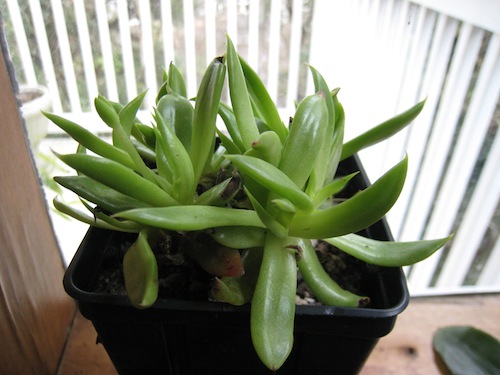
Dudleya cymosa January 2011 in a pot (photo by ALJ)
|
| Dudleya edulis (Nutt.) Moran |
| = Sedum edule Nutt. ex T. & G. 1840 |
| = Echeveria edulis (Nutt. ex T. & G.) A. Berger |
| = Cotyledon edulis (Nutt. ex T. & G.) Brewer |
| (Fingertips. Lady Fingers. Coast, Mission, or San Diego Dudleya. String-bean Plant) |
| S California, north Baja California. 2n = 34 |
| The irony is, despite the specific name edulis, and François Couplan writing "one of the best spp. to eat," (p. 203, The Encyclopedia of Edible Plants of North America; 1998) the specimens of it that I have tasted were all unpleasantly astringent. Moreover, it is generally agreed to be not among the more ornamental species. However, it is relatively easy to grow, and cold-hardy. Reid Moran reports: "though often growing upon other substrates, it is a pioneer colonist on bare granite surfaces in the mountains of Orange, Riverside, and San Diego counties, often the first flowering plant to follow lichens, mosses, and Selaginella." |
It makes low, broad, rubbery mats of slender, upright, pale-green leaves ("shaped like French fries"), often red-tipped, as long as 10 inches, at most half an inch wide. In the wild it is smaller than in cultivation. Flowers, from May into July, are creamy white or soft yellow, fragrant, and relatively wide open and starry for a Dudleya: up to three-forths of an inch wide.
|

Dudleya edulis January 2011 in Berkeley (photo by ALJ)
|
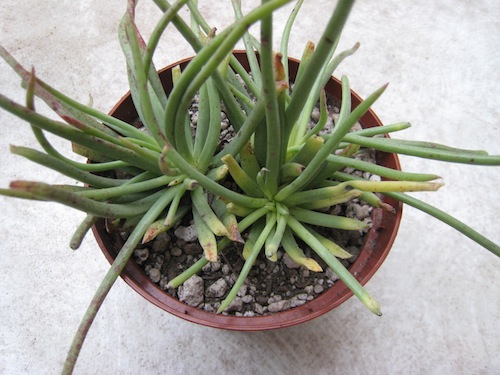
Dudleya edulis January 2011 in a pot (photo by ALJ)
|

small Dudleya edulis January 2011 in ALJ garden (photo by ALJ)
|
| Dudleya lanceolata (Nutt.) Brit. & Rose 1903 |
| = Echeveria lanceolata Nutt. ex T. & G. 1840 |
| (Lanceleaf Live-Forever or Dudleya) |
| California, Baja California. Tetraploid: 2n = 68, 136, ±170 |
| I have zero experience with this Dudleya, but include it because I desire to try it. As with D. edulis, F. Couplan writes that it is a good species to eat. And the website of Annie's Annuals nursery reports of this species: "more adaptable to various situations than most Dudleyas; found hanging onto sunny cliff sides as well as thriving in flat areas. Grows in full sun or shade (best in filtered shade). Clay is fine; it has done well on the Redwood Coast of N California with 40 inches of rain." |
It has sharply pointed green (sometimes glaucous) leaves, as long as 12 inches, at most 1.5 inches wide. Flowers are bright yellow or usually red or red-flushed; April into July.
|
| Dudleya pulverulenta (Nutt. ex T. & G.) Brit. & Rose 1903 |
| = Echeveria pulverulenta Nutt. ex T. & G. 1840 |
| (Mission Lettuce. Chalk Dudleya. Chalk Lettuce. Chalky Live-forever) |
| California, Baja California. 2n = 34 (a close relative that extends into Nevada, Utah and Arizona is D. arizonica Rose 1923) |
The widest range of any Dudleya, over 621 miles (1000 kilometers): Monterey County into Baja California. Like Dudleya Brittonii, it is prized for being large, ghostly chalky pale, with bold drama! Each clump can be as wide as 2 or 3 feet. The largest leaves measure 18 inches long and 5 inches wide. Flowerstems can reach 4 or 5 feet in length, bearing large clusters of red, hummingbird-pollinated flowers. Many people try to cultivate it, but it is not among the easier species to please. It is a Zone 9 plant, though can take as low as 20 degrees F --if briefly. Couplan writes that it is a good species to eat, but I find it astringent.
|

Dudleya pulverulenta January 2011 in Berkeley (photo by ALJ)
|
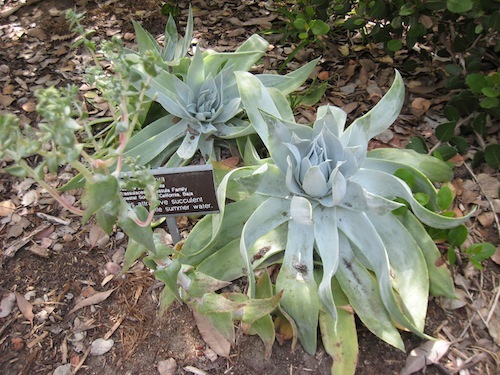
Dudleya pulverulenta May 2010 in San Diego (photo by ALJ)
|
| Dudleya saxosa (M.E. Jones) Brit. & Rose 1903 |
| ssp. Collomiæ (Rose ex C. Morton) Moran 1957 |
| = Dudleya Collomiæ (Collomæ) Rose ex C. Morton 1934 |
| = Echeveria Collomiæ (Rose ex C. Morton) Kearn. & Peeb. 1939 |
| (Gila County Live-Forever) |
| Central Arizona, on rocky (saxosa) slopes. 2n = 136 |
A tufted, silvery-leaved species with bright yellow flowers. Said to be relatively cold hardy (Zone 8b); easy to grow in containers; and Couplan writes that it is a good species to eat --so I desire to try it. Leaves measure up to 6 inches long by an inch wide. Flowers are bright yellow, red-tinged, March into May (October). This subspecies was named after its collector, Rose Eudora Collom (1877 - 1956), Grand Canyon's first paid botanist from 1938 to 1953. You will find the subspecific name spelled either with or without the i.
|
| Dudleya virens (Rose) Moran 1943 ssp. Hessei (Rose) Moran 1995 |
| = Dudleya Hessei (Rose) Moran 1957 |
| (Catalina Live-forever. Hesse's Dudleya, Catalina Island Live-forever) |
| Rocks and cliffs of California's Santa Catalina Island. Tetraploid: 2n = 68 |
| Named after Hermann Edward Hesse (1836 - 1915), German-American lichen expert who botanized much in southern California. Over a dozen plants are named after him. This Dudleya notable for its ease of cultivation. To me, it recalls a gigantic version of Dudleya edulis, that lacks the unpleasantly astringent quality. In brief, it is bigger and better --though not as cold-hardy. The leaves are long and slender, green to whitish, at most measuring 6 inches in length, and about half an inch wide. The flowers are white or rosy, up to .75 of an inch wide; April into June. I believe I have one, bought this month in Berkeley at Cactus Jungle nursery, though its label mistakenly said Dudleya 'White Sprite' --a selection of D. gnoma (Munchkin Dudleya). When mine flowers I can be certain that my guess as to its identity is correct --or can find out that I was wrong. |

Dudleya virens ssp. Hessei May 2010 in San Diego (photo by ALJ)
|
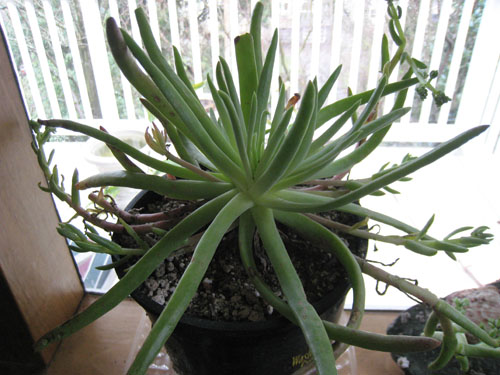
Dudleya virens ssp. Hessei January 2011 in a pot (photo by ALJ)
|
If anyone cares to share their Dudleya experiences with me, especially as to cultivating them outside their native land, or to tasting them, I shall welcome such reports.
Back |

